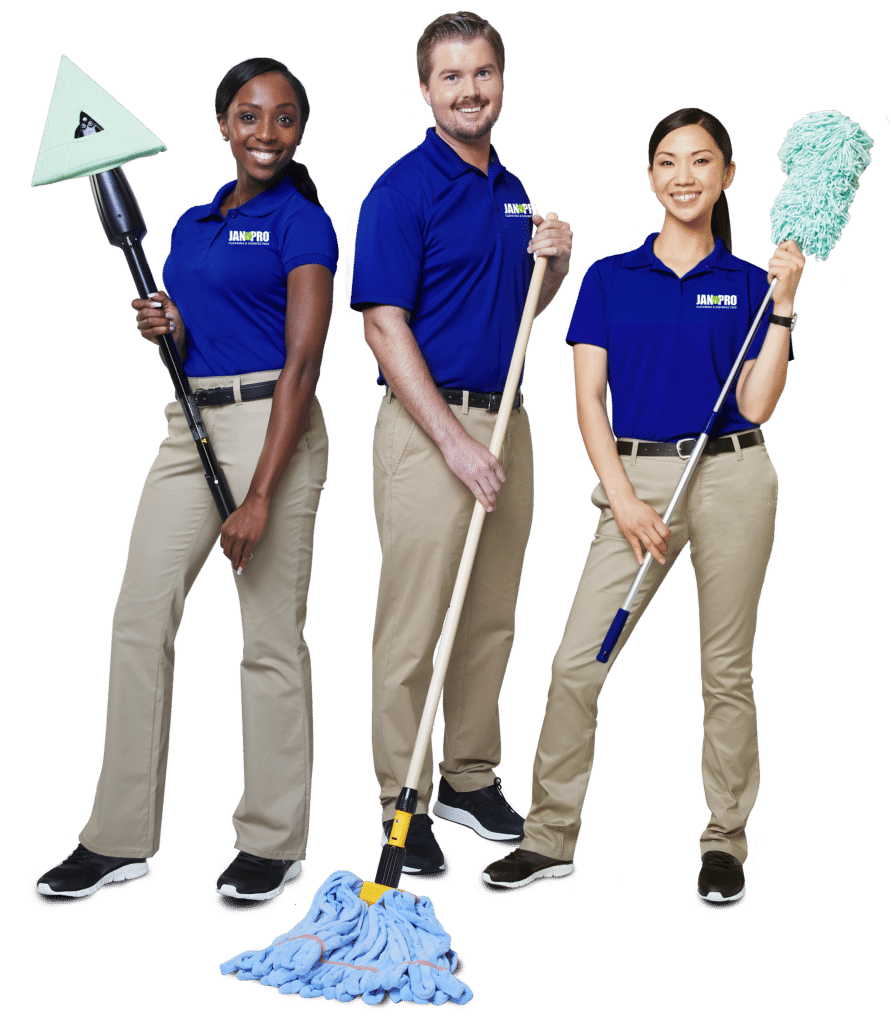There is often misunderstanding over the phrases “sanitize” and “disinfect” when it comes to maintaining a clean workplace. Despite the fact that these phrases are sometimes used synonymously, they relate to separate procedures with different purposes.
Understanding the difference between sanitizing and disinfecting can help you choose the right approach for your needs and maintain a healthier space.
Cleaning, Sanitizing, and Disinfecting: What’s the Difference Between the Three?
Before we discuss the difference between sanitizing and disinfecting, it helps first to explain what cleaning exactly entails.
Cleaning is the first step in maintaining a pristine environment. It involves removing dirt, dust, crumbs, and other impurities from surfaces using soap, or detergent, and water.
It’s worth noting that while cleaning removes grime and germs from surfaces, it doesn’t kill them. It may be sufficient for maintaining a tidy appearance, but it doesn’t necessarily reduce the risks of infection from viruses and bacteria.
Sanitizing goes a step further by using chemicals or other methods to reduce the number of germs on surfaces or objects to levels determined safe by public health standards or requirements. However, this process does not eliminate viruses or fungi, and the sanitization’s effectiveness can be quickly compromised by subsequent contamination.
Finally, disinfecting is a more intensive process than both cleaning and sanitizing. It involves using disinfectant chemicals to kill various infection-causing microorganisms on surfaces, including viruses, bacteria, and fungi. Disinfectants are more potent and require a specific contact time on the surface to be effective.
With that said, disinfecting isn’t meant to clean dirty surfaces. It’s intended to kill germs that remain after cleaning to lower the risk of spreading infection further.
 Sanitize vs. Disinfect: When To Perform Each
Sanitize vs. Disinfect: When To Perform Each
Choosing whether to sanitize or disinfect often depends on the situation at hand and the levels of hygiene required.
When To Sanitize
Sanitizing is most appropriate for surfaces that come into contact with food and items children or pets use. These are best cleaned without harsh chemicals and are surfaces where a safe level of bacteria is acceptable. Examples include kitchen countertops, dining tables, toys, and pet areas.
When To Disinfect
Disinfecting should be reserved for areas with a higher risk of contamination, such as hospitals, clinics, and areas that have come into contact with bodily fluids. Other places where disinfecting is crucial include:
- Bathroom Surfaces: Toilets, sinks, and shower areas can harbor various pathogens.
- Sick Rooms: When someone is ill, disinfecting surfaces they’ve touched is crucial in preventing the spread of illness.
- High-touch Areas: Doorknobs, light switches, and phones must be disinfected as they are frequent points of contact for hands.
As a general guideline, it is advisable to disinfect an area where there is a greater chance of pathogen presence or transmission.
Learn more about Medical Office Cleaning with this Checklist
Clarifying the Confusion Between Sanitizing and Sanitation
Other phrases that often cause misunderstanding include “sanitation” and “sanitizing.” On the other hand, in the context of a clean environment, they have different connotations.
Sanitizing specifically refers to the process of reducing bacteria to safe levels on the individual surface or item. It’s an activity performed regularly as part of a routine cleaning schedule.
Sanitation, on the other hand, encompasses the broader spectrum of maintaining a hygienic and healthful environment. This includes proper handling and disposal of waste, adequate sewage control, and the regular cleaning and sanitizing of surfaces. Ultimately, it covers the overall management of cleanliness and hygiene in facilities.
Experience Unmatched and Reliable Cleanliness From Certified Commercial Cleaners
While it’s beneficial to understand the difference between sanitizing and disinfecting, effectively performing them requires time, knowledge, and the right supplies. If your business, industrial facility, or any other commercial establishment regularly receives large volumes of people, proper cleaning, sanitizing, and disinfecting are crucial in maintaining a safe and healthy environment.
Commercial cleaners understand the nuances of different cleaning methods and chemicals. They know how to use high-grade disinfectants effectively to tackle pathogens in public or high-traffic environments. Best of all, they adhere to regulations to ensure your establishment meets health and safety codes.
If you’re still looking for certified experts to entrust your business’s cleanliness to, consider JAN-PRO Cleaning & Disinfecting for the confidence that comes from a thoroughly sanitized and disinfected workplace. Request your free estimate today to get started and discover how commercial cleaners can help you attain the highest standard of cleanliness and safety.
Cleaning and disinfecting services provided by independently owned and operated JAN-PRO Cleaning & Disinfecting franchisees.

 Sanitize vs. Disinfect: When To Perform Each
Sanitize vs. Disinfect: When To Perform Each